
Features
Crop Culture
Inputs
Growing in the Green: Your recipe for success
December 2, 2009 By Melhem Sawaya
We grow poinsettias once a year and, from one crop to the next, there is enough time for our memory to fail us on what we want to change and the improvements we want to apply to the next crop.
We grow poinsettias once a year and, from one crop to the next, there is enough time for our memory to fail us on what we want to change and the improvements we want to apply to the next crop.
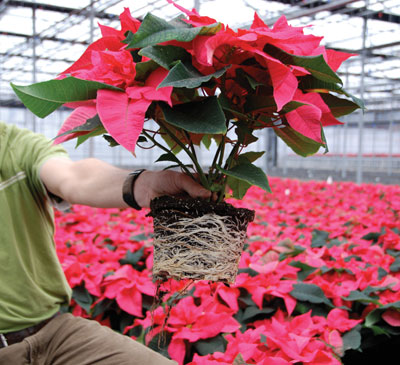 |
|
| Excellent roots makes growing a crop a pleasure. |
|
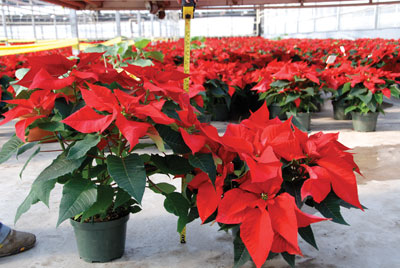 |
|
| A PGR treated 6” pot vs. control and recording height difference. |
|
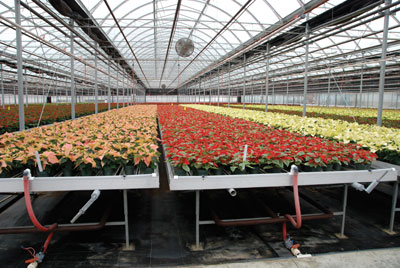 |
|
| Multi varieties of 41⁄2” point grown in the same environment but growth regulator application vary. |
|
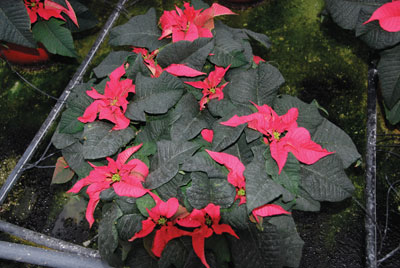 |
|
| Over-treatment of growth regulator kept the bract small. |
|
 |
|
| Excellent bract size and even breaks excellent example when every growing function is done on time. |
|
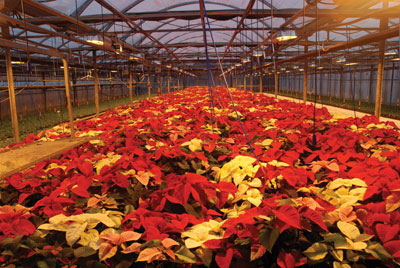 |
|
| A late crop, lit pass oct. 3, then high intensity lights applied during the day to enhance colouring. |
|
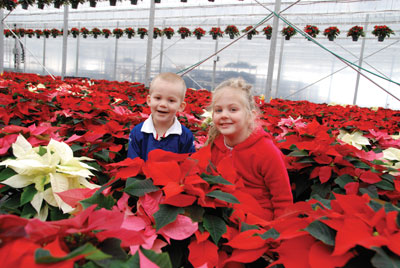 |
|
| Nathan and Jenny Huck, of Colour Paradise Greenhouses in Mannheim, Ontario, in a greenhouse of predominately red varieties. |
|
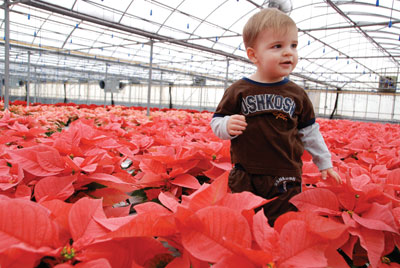 |
|
| Riley Stigter, of Warren Greenhouses in Kitchener, represents the fourth generation of his family involved in the greenhouse industry. Advertisement
|
If we grow a good crop, we like to do it again and, if our crop was poor, we would like to make the changes required. In either case, the change to – or repetition of – our growing program requires concrete information from the previous season’s crop.
If you already keep records, that is great, but don’t stop there. Make sure you add another column or crop sheet to record what you would like to see happen next year.
If you don’t have records, it is still feasible at this time to recall or gather the scattered information to give you a starting point to begin records so you can document next year’s plan. If the information is not complete, that is still okay, because the important thing is to have a plan for next year’s crop and to get into the habit of planning the next crop.
The technology for growing poinsettia is quite diverse and the information sources are many. However, as good as the information sources are, they only reflect specific environmental conditions and practices that normally are not detailed with the emphasis on one aspect of growing the plants. These details include variety choice, chemicals, fertilizers, temperature deliverance, watering method, growth regulator treatment (chemically or culturally), number of cuttings per pot, different varieties to different pot sizes, various packaging (rings, sleeves and pot covers), shipping temperatures, and length of time in shipping before the plants reach your customers.
Needless to say, taking one new aspect that is recommended by anybody is both beneficial and dangerous at the same time. It’s beneficial because that is how we improve our culture, as long as we apply the new information on a small scale and wait until the next crop to fully adopt the new culture or product. But it can also be dangerous due to not knowing the rest of the aspects currently being applied to that crop.
Since growing poinsettia, or any other crop, is totally an integrated process, changing one aspect normally means adjusting some of the methods and applications that we currently use to grow our crop.
Here are some guidelines on crop (or more specifically poinsettia) record-keeping and explanations.
Create a form/spreadsheet as a template that you will use to record your data. I’ve developed a sample spreadsheet you can print. It can be found on the Greenhouse Canada website in the Web Exclusives section. Click on CROP COOKBOOK to download this PDF.
Starting with the timing of rooting your poinsettias and the media used, the condition of the cuttings, temperature at which they were rooted at, days it took to root, and condition or quality of the rooted cuttings upon planting all have an impact on the crop finished product, timing and quality.
CUTTING ROOTING
If you are rooting your own cuttings, then a “cookbook” is needed just to cover rooting cuttings and should include:
| • | Temperatures, day and night, from Day One (sticking day) until finish. |
| • | Misting cycles and duration – Day One to finish. |
| • | Any treatments (growth regulators, fungicides, etc.). |
| • | Fertilizer programs. |
| • | A listing of any abnormal conditions according to your practices. |
| • | Any program does not apply to all varieties – adjustments must be made to the program to accommodate the varieties. |
| • | Record of planting, pinching, spacing, and the schedule of lights/blackout are very important in crop development – from root development to finish. |
Even the date of the crop going from handwatering to trough, floor or drip irrigation is important. This is because the breaks in development after pinching and type of irrigation will affect the root development.
MEDIA
Document the media that drains well and has good aeration, because poinsettia roots need lots of oxygen for proper growth – especially during the dark fall weather.
Good records of the soil mixes is a must – remember some have one tradename but come in different analysis specs. You need to know your media composition by per cent and know the nutrient charge and lime types and the ratio to each other.
WATER
It’s important to record your water analysis, type of irrigation, and whether you are a wet grower or a dry grower. Was there a time you forgot the crop and it was extremely dry for 24 hours or more, because this will affect the crop through to the end. If handwatering, note if a different person is watering the crop.
FERTILIZER
List the average temperature set and what actually happened. You can accelerate or delay a crop by up to two weeks just by temperature control.
GROWTH REGULATOR
Growth regulator applications and recording height measurements require you to make sure you record the rate, volume used and at what stage, and environmental conditions.
IPM
Record all treatments – biological or chemical – and at what growth stage the plants are at with the treatments. Also, record any signs of phytotoxicity and treatment effectiveness.
PLANT READY vs. SALE TARGET READY
Hopefully, when you planted the crop, you had in mind a target sale date, which is great if it is the same date the plants are ready for sale. However, if it is not, a record of plant-ready dates will allow you to make the necessary adjustments to have the plant-ready date on the sale-target date.
VARIETY SELECTION
There are over 150 varieties on the market, which could be good – giving us a lot of choice – or bad, because we don’t have time to try them all to know what to choose. However, always at the end of the crop, you know very well the varieties that performed well and those that didn’t. After analyzing the reasons why some varieties didn’t work – and knowing it was an inferior variety and not the result of you not doing something right, then it is time to drop that variety and pick one from those you are trialing. Two or three per cent of any crop should be devoted to trialing, allowing you to improve on variety selection.
TECHNOLOGY
With all the modern technology of computers, digital cameras and scanners, etc., it is important to take advantage of them by having computerized cookbooks that include graphical tracking and soil tests, among other reports. You should also include digital photos of the crop development – with dates – so you can refer to them next season.
Planning is the basis for any successful venture. It must be timely and targeted. It is like a pilot flying a plane – they always have a flight plan to their destination. However, they must constantly make course corrections because outside factors – such as wind and cloud cover – will take the plane off the desired path. It is important to keep your destination in mind and make corrections as you go.
This is true for life in general. Have a target, a purpose, do all your homework, and then put together a plan on how to reach your target. Admit your mistakes and learn from them, and by changing with new methods or practices, achieving your target is always possible.
Always be prepared to Look for something new to learn. Ask questions about the things you are not familiar with. Listen to others (colleagues, seminars or other information sources), and then Act – on a trial basis – on the information and then expand your usage if it is an improvement. By practising this sequence, you would put a different meaning to being in “LALA Land” because you will be a successful person and the envy of others.
Melhem Sawaya of Focus Greenhouse Management is a consultant and research co-ordinator to the horticultural industry. Comments on this or any other article are always welcome; please e-mail mel@focusgreenhousemanagement.com, or visit www.focusgreenhousemanagement.com or www.sawayagardentrials.ca.
Print this page